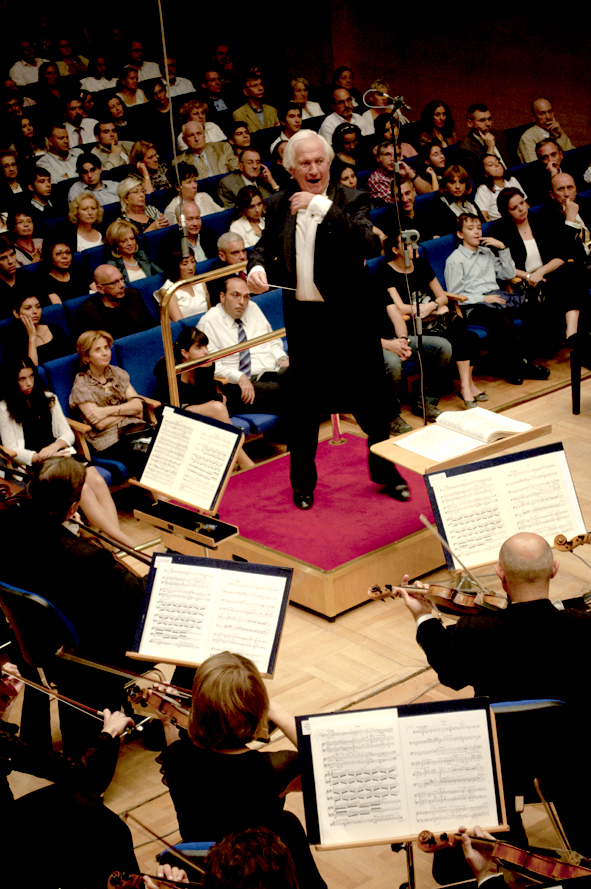Mozart, Mahler, Modernism Open the BSO
Kate Sampsell-Willmann
Bilkent News
The Bilkent Symphony opened its 2010-2011 season Friday night with a performance of Mozart's Sinfonie Concertante in E flat major, KV. 364 and Mahler's Symphony No. 4 in G major.
Although a bouquet of flowers occupied the first violin's chair during Mahler, Irina Nikotina of the BSO performed in the place of the concertmaster for Mozart. The schedule of the BSO for this academic year had been set before the sad loss, on September 4, 2010, of BSO Concertmaster Server Ganiyev.
Last week, Bilkent News published a commentary discussing the vision behind pairing Mozart with Mahler. The theme in common between these two disparate compositions was thought to be Vienna and the bookends of empire. In the performances of Sayaka Shoji, and Naoko Shimizu especially, it is readily apparent what these two compositions have in common: the magnificent angst of uncertainty: Mozart exiled to Salzburg, Mahler facing the turn of the twentieth century.
The third movement of the concertante, the presto, is the usual crowd pleaser with its upbeat celebration of all things rational. On Friday, however, the second movement banished the 18th century when Sayaka and Naoko had deftly transformed the heart of the concertante into a proto-modernist struggle. The presto became almost superfluous. The counterpoise between the violin and the aggressively played viola took Mozart from the late baroque and very nearly made him a figure of fin de siècle introspection. As noted in BN's preview, Mozart composed the viola piece in a higher key, and violists traditionally tuned their instruments just a wee bit sharper to stand up to the brighter violin. Naoko performed in E flat with perfectly tuned strings. Yet, Naoko managed to achieve the same sharp effect through an agonistic, almost angry, attack on the score. Her performance, emotionally engaged with Sayaka's almost effortless execution, transformed the concertante from baroque révérénce into vigorous and asymmetrical modern dance, challenging and ultimately destroying traditional expectations. Bravissima. In the strings of Sayaka's violin and Naoko's viola, Mozart was dragged kicking and screaming into the end of the 19th century. The presto afterwards sounded perfunctory in comparison.
This unorthodox, passionate, and brilliant performance prepared the audience for the modernist Mahler. And yes, at times Symphony No. 4 sounds nostalgic and sweet. However, when one considers the true nature of "nostalgia" - that it is not a longing for an actual past but for an idealized memory, a time when things seemed, in contrast with the present, to be so much simpler and happier - ultimately, nostalgia is revealed as mirage. Bucolic daydreams of late -19th-century artists, born into age torn apart and reconstructed by the ugliness of industrial revolution, poised over the abyss of World War, often included references to a soft and gentle past. And just as often, such pining is juxtaposed with the harshness of industrial life. Mahler may have pastorally rounded the lines between his gouging geometry; yet, nostalgic is not the correct adjective. Mahler composed a Hegelian teleology, a symbolic (or "cymbalic") clash of history driving to a determined but unknowable future.
The occasional softness of phrasing in the 4th is too often interspersed with bows sharpened into spearheads to call this most astonishing piece of music anything but a sound picture of emotional crisis. What emerges is not so much counterpoise, as was the case in the soloists' violin/viola duel, but the intrusiveness of memory upon the psyche ravaged by industrial reality. Picture the worker cog in the Sisyphean factory-machine and how occasional memories of self-sufficient farm life might intrude into the drudge, filth, dullness, and violence of the assembly line. That is Mahler's 4th, more Eliot than Enlightenment, more Brazil than Amadeus.
Naïra Abrahamyan's excellent performance carried the last movement of Mahler's 4th to its intended anticlimactic and insecure end. Far from a denouement, the 4th concluded "not with a bang but with a whimper." One could discern the disquiet in the composer's mind as the 19th century came to a close. Witnessed from the 21st century, Mahler's resignation in the final notes almost sounded like the calm before the machine-fueled and carnage-riddled storm of World War I. Nothing ever would really be the same. Wisps of elusive memory were all that were left to the modern.
BSO music director Klaus Weise conducted. Weise is a regular conductor in many symphonies around the world and has been the principal guest conductor of the Beijing Symphony Orchestra. Violin soloist Sayaka Shoji is the youngest person (at 17) to win the notoriously competitive Paganini Competition (1999). She has recorded with Zebin Muhta conducing the Israel Philharmonic Orchestra and Myun-Whun Chung conducting the Orchestre Philharmonique de Radio France. Violist Naoko Shimizu is the principal violist of the Berlin Symphony Orchestra, the first woman to hold the post. In 1992, the year she changed instruments from the violin to the viola, the Boston Symphony Orchestra invited Shimizu to perform at their annual Tanglewood Festival. Soprano Naïra Abrahamyan attended the Juliard Conservatory of Music in New York and has spent most of her career performing in her native Armenia.
